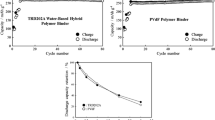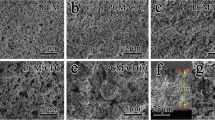Abstract
Polymeric binders play an important role in maintaining the integrity of electrodes and improving the electrochemical performance of batteries. Unlike binders soluble in organic solvents, water-soluble binders are environmentally friendly and easy to recycle. In this work, a comparative study on the effects of water-soluble cyclodextrin and organic-based PVDF binders on the Li+ intercalation/deintercalation of lithium-ion batteries with Li2ZnTi3O8 anode is conducted for the first time. Compared to α-cyclodextrin, γ-cyclodextrin, and PVDF, LZTO with β-cyclodextrin binder exhibits larger Li+ storage capacity, better cycle stability, rate capability, and higher Coulombic efficiency, possessing a high electrical conductivity, low charge transfer resistance, and fast lithium-ion diffusion coefficient. β-Cyclodextrin water-soluble binder not only makes the active material difficult to separate from the current collector and facilitates favorable electrochemical kinetics but also maintains good cycle stability at high temperatures. Utilizing these advantageous features, β-Cyclodextrin-based LZTO electrode shows markedly improved reversible Li+ storage performance compared to those of other binder cases.
Graphical abstract









Similar content being viewed by others
References
Armand M, Tarascon JM (2008) Building better batteries. Nature 451:652–657
Dunn B, Kamath H, Tarascon JM (2011) Electrical energy storage for the grid: a battery of choices. Science 334:928–935
Wook Choi J, Aurbach D (2016) Promise and reality of post-lithium-ion batteries with high energy densities. Nat Rev Mater 1:1–16
Liu Q, Su X, Lei D, Qin Y, Wen JG, Guo FM, Wu YA, Rong YC, Kou RH, Xiao XH, Aguesse F, Bareño J, Ren Y, Lu WQ, Li YX (2018) Approaching the capacity limit of lithium cobalt oxide in lithium ion batteries via lanthanum and aluminium doping. Nat Energy 3:936–943
Wang C, Li ZH, Liu HM, Wang YG (2017) Improved electrochemical performance of a Li3V2(PO4)3 cathode in a wide potential window for lithium-ion storage by surface N-doped carbon coating and bulk K-doping. New J Chem 41:8772–8780
Wang JJ, Sun XL (2012) Understanding and recent development of carbon coating on LiFePO4 cathode materials for lithium-ion batteries. Energy Environ Sci 5:5163–5185
Liang GM, Peterson VK, See KW, Guo ZP, Pang WK (2020) Developing high-voltage spinel LiNi0.5Mn1.5O4 cathodes for high-energy-density lithium-ion batteries: current achievements and future prospects. J Mater Chem A 8:15373–15398
Zhao BT, Deng X, Ran R, Liu ML, Shao ZP (2016) Facile synthesis of a 3D nanoarchitectured Li4Ti5O12 electrode for ultrafast energy storage. Adv Energy Mater 6:1500924
Zhang H, Yang Y, Ren DS, Wang L, He XM (2021) Graphite as anode materials: fundamental mechanism, recent progress and advances. Energy Stor Mater 36:147–170
Zhong HX, He AQ, Lu JD, Sun MH, He JR, Zhang LZ (2016) Carboxymethyl chitosan/conducting polymer as water-soluble composite binder for LiFePO4 cathode in lithium ion batteries. J Power Sources 336:107–114
Jeong YK, Kwon TW, Lee I, Kim TS, Coskun A, Choi JW (2014) Hyperbranched β-cyclodextrin polymer as an effective multidimensional binder for silicon anodes in lithium rechargeable batteries. Nano Lett 14:864–870
Ryou MH, Kim J, Lee I, Kim SJ, Jeong YK, Hong S, Ryu JH, Kim TS, Park JK, Lee H, Choi JW (2013) Mussel-inspired adhesive binders for high-performance silicon nanoparticle anodes in lithium-ion batteries. Adv Mater 25:1571–1576
Han ZJ, Yabuuchi N, Shimomura K, Murase M, Yuib H, Komaba S (2012) High-capacity Si-graphite composite electrodes with a self-formed porous structure by a partially neutralized polyacrylate for Li-ion batteries. Energy Environ Sci 5:9014–9020
Markevich E, Salitra G, Aurbach D (2005) Influence of the PVdF binder on the stability of LiCoO2 electrodes. Electrochem Commun 7:1298–1304
Hwang SS, Sohn M, Park H.-Il, Choi J-M, Cho CG, Kim H (2016) Effect of the heat treatment on the dimensional stability of Si electrodes with PVDF binder. Electrochim Acta 211(356):363
Courtel FM, Niketic S, Duguay D, A.-Lebdeh Y, Davidson IJ (2011) Water-soluble binders for MCMB carbon anodes for lithium-ion batteries. J. Power Sources 196(2128):2134
Zhang Z, Zeng T, Qu C, Liu H, Jia M, Lai Y, Li J (2012) Cycle performance improvement of LiFePO4 cathode with polyacrylic acid as binder. Electrochim Acta 80:440–444
Lux SF, Schappacher F, Balducci A, Passerini S, Winter M (2010) low cost, environmentally benign binders for lithium-ion batteries. J Electrochem Soc 157(3):A320–A325
Wang N, NuLi YN, Su SJ, Yang J, Wang JL (2017) Effects of binders on the electrochemical performance of rechargeable magnesium batteries. J Power Sources 341:219–229
Zou F, Manthiram A (2020) A review of the design of advanced binders for high performance batteries. Adv Energy Mater 10:2002508
Sano A, Kurihara M, Ogawa K, Iijima T, Maruyama S (2009) Decreasing the initial irreversible capacity loss of graphite negative electrode by alkali-addition. J Power Sources 192:703–707
Chou SL, Wang JZ, Zhong C, Rahman MM, Liu HK, Dou SX (2009) A facile route to carbon-coated SnO2 nanoparticles combined with a new binder for enhanced cyclability of Li-ion rechargeable batteries. Electrochim Acta 54:7519–7524
Kim GT, Jeong SS, Joost M, Rocca E, Winter M, Passerini S, Balducci A (2011) Use of natural binders and ionic liquid electrolytes for greener and safer lithium-ion batteries. J Power Sources 196:2187–2194
Li J, Kloepsch R, Nowak S, Kunze M, Winter M, Passerini S (2011) Investigations on cellulose-based high voltage composite cathodes for lithium ion batteries. J Power Sources 196(18):7687–7691
He M, Yuan LX, Zhang WX, Hu XL, Huang YH (2011) Enhanced cyclability for sulfur cathode achieved by a water-soluble binder. J Phys Chem C 115:15703–15709
Zhang ZA, Bao WZ, Lu H, Jia M, Xie KY, Lai YQ, Li J (2012) Water-soluble polyacrylic acid as a binder for sulfur cathode in lithium-sulfur battery. ECS Electrochem Lett 1:A34
Bao WZ, Zhang ZA, Gan YQ, Wang XW, Lia J (2013) Enhanced cyclability of sulfur cathodes in lithium-sulfur batteries with Na-alginate as a binder. J Energy Chem 22:790–794
Pan J, Xu GY, Ding B, Han JP, Dou H, Zhang XG (2015) Enhanced electrochemical performance of sulfur cathodes with a water-soluble binder. RSC Adv 5:13709–13714
Qiu L, Shao ZQ, Wang DX, Wang WJ, Wang FJ, Wang JQ (2014) Enhanced electrochemical properties of LiFePO4 (LFP) cathode using the carboxymethyl cellulose lithium (CMC-Li) as novel binder in lithium-ion battery. Carbohyd Polym 111:588–591
Gaberscek M, Bele M, Drofenik J, Dominko R, Pejovnik S (2001) Improved carbon anode properties: pretreatment of particles in polyelectrolyte solution. J Power Sources 97:67–69
Qiu LW, Shen YD, Fan HB, Yang XW, Wang C (2018) Carboxymethyl fenugreek gum: rheological characterization and as a novel binder for silicon anode of lithium-ion batteries. Int J Biol Macromol 115:672–679
Zhang ZA, Bao WZ, Lu H, Jia M, Xie KY, Lai YQ, Li J (2012) Water-soluble polyacrylic acid as a binder for sulfur cathode in lithium-sulfur battery. ECS Electrochem Lett 1(2):A34–A37
Komaba S, Yabuuchi N, Ozeki T, Okushi K, Yui H, Konno K, Katayama Y, Miura T (2010) Functional binders for reversible lithium intercalation into graphite in propylene carbonate and ionic liquid media. J Power Sources 195:6069–6074
Park HK, Kong BS, Oh ES (2011) Effect of high adhesive polyvinyl alcohol binder on the anodes of lithium ion batteries. Electrochem Commun 13:1051–1053
Tang HQ, Weng Q, Tang ZY (2015) Chitosan oligosaccharides: a novel and efficient water soluble binder for lithium zinc titanate anode in lithium-ion batteries. Electrochim Acta 151:27–34
Kovalenko I, Zdyrko B, Magasinski A, Hertzberg B, Milicev Z, Burtovyy R, Luzinov I, Yushin G (2011) A major constituent of brown algae for use in high-capacity Li-ion batteries. Science 333:75–79
Ohta N, Sogabe T, Kuroda K (2001) A novel binder for the graphite anode of recharge-able lithium ion batteries for the improvement of reversible capacity. Carbon 39(9):1434–1436
Liu J, Zhang Q, Sun Y-K (2018) Recent progress of advanced binders for Li-S batteries. J Power Sources 396:19–32
Liu J, Sun MH, Zhang Q, Dong FF, Kaghazchi P, Fang YX, Zhang SQ, Lin Z (2018) A robust network binder with dual functions of Cu2+ ions as ionic crosslinking and chemical binding agents for highly stable Li-S batteries. J Mater Chem A 6:7382–7388
Hu LL, Zhang XD, Li B, Jin MH, Shen XH, Luo ZW, Tian ZY, Yuan LZ, Deng JK, Dai ZF, Song JX (2021) Design of high-energy-dissipation, deformable binder for high-areal-capacity silicon anode in lithium-ion batteries. Chem Eng J 420:129991
Jiao XX, Yin JQ, Xu XY, Wang JL, Liu YY, Xiong SZ, Zhang QL, Song JX (2020) Highly energy-dissipative, fast self-healing binder for stable Si anode in lithium-ion batteries, Adv Funct Mater. 2005699
Hu LL, Zhang XD, Zhao PY, Fan H, Zhang Z, Deng JK, Ungar G, Song JX (2021) Gradient H-bonding binder enables stable high-areal-capacity Si-based anodes in pouch cells. Adv Mater. 2104416
Liu T, Tang HQ, Liu JY, Pu YJ, Zhang J, Lu ZW, Li W, Tang ZY, Ding F (2018) Improved electrochemical performance of Li2ZnTi3O8 using carbon materials as loose and porous agent. Electrochim. Acta 259:28–35
Miao XW, Ni H, Zhang H, Wang CG, Fang JH, Yang G (2014) Li2ZrO3-coated 0.4 Li2MnO3·0.6LiNi1/3Co1/3Mn1/3O2 for high performance cathode material in lithium-ion battery. J. Power Sources 264:147–154
Ge H, Li N, Li D, Dai C, Wang D (2008) Electrochemical characteristics of spinel Li4Ti5O12 discharged to 0.01 V. Electrochem. Commun. 10:719–722
Borghols WJH, Wagemaker M, Lafont U, Kelde EM, Mulder FM (2009) Size effects in the Li4+xTi5O12 spinel. J. Am Chem. Soc. 131:17786–17792
Nguyen MHT, Oh E-S (2015) Improvement of the characteristics of poly(acrylonitrile–butylacrylate) water-dispersed binder for lithium-ion batteries by the addition of acrylic acid and polystyrene seed. J Electroanal Chem 739:111–114
Qin JL, Zhu HL, Lun N, Qi YX, Bai YJ (2020) Li2ZnTi3O8/C anode with high initial Coulombic efficiency, long cyclic life and outstanding rate properties enabled by fulvic acid. Carbon 163:297–307
Kuvshinov A, Pesin L, Chebotaryov S, Kuznetsov M, Evsyukov S, Sapozhnikova T, Mirzoev A (2008) Kinetics of radiation-induced carbonization of poly(vinylidene fluoride) film surface. Polym Degrad Stab 93:1952–1955
El Mohajir B-E, Heymans N (2001) Changes in structural and mechanical behaviour of PVDF with processing and thermomechanical treatments. 1 Change in structure. Polymer 42:5661–5667
Wang F, Borodin O, Gao T, Fan XL, Sun W, Han FD, Faraone A, Dura JA, Xu K, Wang CS (2018) Highly reversible zinc metal anode for aqueous batteries. Nat Mater 17:543–549
Ai LH, Gao XY, Jiang J (2014) In situ synthesis of cobalt stabilized on macroscopic biopolymer hydrogel as economical and recyclable catalyst for hydrogen generation from sodium borohydride hydrolysis. J Power Sources 257:213–220
Funding
This work was supported by the National Natural Science Foundation of China (Grant No. 51702081).
Author information
Authors and Affiliations
Corresponding author
Ethics declarations
Conflict of interest
The authors declare no competing interests.
Additional information
Publisher's note
Springer Nature remains neutral with regard to jurisdictional claims in published maps and institutional affiliations.
Supplementary Information
Below is the link to the electronic supplementary material.
Rights and permissions
About this article
Cite this article
Wang, L., Han, Z., Weng, Q. et al. Cyclodextrin polymers as effective water-soluble binder with enhanced cycling performance for Li2ZnTi3O8 anode in lithium-ion batteries. Ionics 28, 669–682 (2022). https://doi.org/10.1007/s11581-021-04374-6
Received:
Revised:
Accepted:
Published:
Issue Date:
DOI: https://doi.org/10.1007/s11581-021-04374-6




